
1st grade science key vocabulary English/Spanish translations (space to add drawing as well).
- Material Type:
- Lesson Plan
- Date Added:
- 06/01/2012

1st grade science key vocabulary English/Spanish translations (space to add drawing as well).
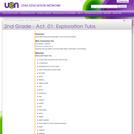
The focus of this lesson is to provide an opportunity for children to develop oral language skills and to record their oral language to share with others.

Join Simon, Anita, Emily and the rest of Ms. Patel's class as they gain an understanding of how the Earth works as a system while preparing their end of the school year play.

The Amazing Mundo is part of OLogy, where kids can collect virtual trading cards and create projects with them. In this interactive comic strip (also available as a printable PDF), kids are challenged to determine the composition of everyday objects. They learn the variety of things made from materials like sand, metal, bauxite and oil.

Word Count: 7198
(Note: This resource's metadata has been created automatically by reformatting and/or combining the information that the author initially provided as part of a bulk import process.)

LiDAR-Derived Digital Outcrops, 3D Hand Samples, Petrography, and Geochemistry
Short Description:
Classic Central Gneiss Belt of the Grenville outcrops are revealed in this image-dense geological reference book. Each site is complete with 3D models of outcrops, rock samples, and virtual thin sections. Geochemical data is also available for some samples. High resolution images of thin sections and more detailed descriptions are available to post-secondary instructors upon request.
Word Count: 7112
(Note: This resource's metadata has been created automatically by reformatting and/or combining the information that the author initially provided as part of a bulk import process.)

LiDAR-Derived Digital Outcrops, 3D Hand Samples, Petrography, and Geochemistry
Short Description:
Classic Central Metasedimentary Belt of the Grenville outcrops are revealed in this image-dense geological reference book. Each site is complete with 3D models of outcrops, rock samples, and virtual thin sections. Geochemical data is also available for some samples. High resolution images of thin sections and more detailed descriptions are available to post-secondary instructors upon request.
Word Count: 5365
(Note: This resource's metadata has been created automatically by reformatting and/or combining the information that the author initially provided as part of a bulk import process.)
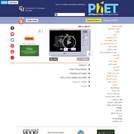
Experiment with a helium balloon, a hot air balloon, or a rigid sphere filled with different gases. Discover what makes some balloons float and others sink.
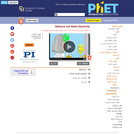
Why does a balloon stick to your sweater? Rub a balloon on a sweater, then let go of the balloon and it flies over and sticks to the sweater. View the charges in the sweater, balloons, and the wall.

This learning video uses a simple analog setup to explore why earthquakes are so unpredictable. The setup is simple enough that students should be able to assemble and operate it on their own with a teacher's supervision. The teaching approach used in this module is known as the 5E approach, which stands for Engagement, Exploration, Explanation, Elaboration, and Evaluation. Over the course of this lesson, the basic mechanisms that give rise to the behavior of the simple analog system are explained, and further elaboration helps the students to apply their understanding of the analog system to complex fault systems that cause earthquakes
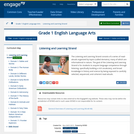
The goal of the Listening and Learning Strand is for students to acquire language competence through listening, specifically building a rich vocabulary, and broad knowledge in history and science by being exposed to carefully selected, sequenced, and coherent read-alouds. The 9 units (or domains) provide lessons (including images and texts), as well as instructional objectives, core vocabulary, and assessment materials. The domain topics include: Different Lands, Similar Stories; Fables and Stories; The Human Body; Early World Civilizations; Early American Civilizations; Astronomy; Animals & Habitats; Fairy Tales; and History of the Earth.
Find the rest of the EngageNY ELA resources at https://archive.org/details/engageny-ela-archive .
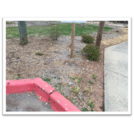
Students will understand that wind and water can change the shape of the land. And that because there is always more than one possible solution to a problem, it is useful to compare and test designs.
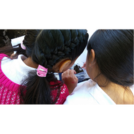
Students will observe and describe the properties of soil for texture, size, color and ability to support life.

This 10-minute video lesson looks at the beginnings of life on Earth. Life and photosynthesis start to thrive in the Archean Eon. [Cosmology and Astronomy playlist: Lesson 39 of 85]
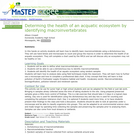
This lab activity allows students to indetify macroinvertebrates and determine the health of an acquatic ecosystem.

An Introduction to Soil Science
Short Description:
Written entirely by members of the Canadian Society of Soil Science, "Digging into Canadian Soils: An Introduction to Soil Science" provides an introduction to the core disciplines of soil science, and introduces the concepts and vocabulary needed by students just beginning their soil science journey. The textbook provides supplementary materials that are specific to regions in Canada, or may be of specific interest beyond what might be considered introductory soil science material. Importantly, the textbook also is intended to introduce students to the Canadian System of Soil Classification by providing examples from across the length and breadth of the world’s second largest country, and to the Canadian Society of Soil Science, whose members share a common passion for soil science and are keen to share and instill this passion with students across Canada.
Long Description:
Written, reviewed and edited by members of the Canadian Society of Soil Science, Digging into Canadian Soils: An Introduction to Soil Science provides an introduction to the core disciplines of soil science (pedology, soil biology and microbiology, physics, chemistry, fertility and nutrient cycling, and management), and introduces the concepts and vocabulary needed by students just beginning their soil science journey. The textbook is appropriate for use in a number of disciplines, including environmental and agricultural sciences, as well as related geology, geography and natural resources engineering disciplines.
Chapters within the textbook are presented in three sections according to the content and level of the complexity. The first section of the book, Digging In, introduces core disciplines in a series of chapters written by authors whose research expertise informs the chapter content. Supplementary materials that are specific to regions in Canada are presented in chapters within a second section, Digging Across Canada. The third section, Digging Deeper, provides in-depth overview of some topics beyond what is considered core soil science disciplinary material, and may be appropriate for upper level soil science or related discipline courses. The textbook includes an extensive glossary that is accessible via in-text links. Importantly, the textbook is intended also to introduce students to the Canadian System of Soil Classification by providing examples from across the length and breadth of the world’s second largest country, and to the Canadian Society of Soil Science, whose members share a common passion for soil science and are keen to share and instill this passion with students across Canada.
Word Count: 182572
ISBN: 978-0-88880-668-0
(Note: This resource's metadata has been created automatically by reformatting and/or combining the information that the author initially provided as part of a bulk import process.)

Join Simon, Anita and Dennis as they explore the names of clouds. And what's a Contrail?Download the Clouds Module storybook and learning activities!
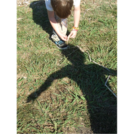
Students know that there are recognizable patterns on earth.To demonstrate the rotation of earth, students will track the shadows on a sundial throughout the day.
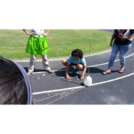
Students know that there are recognizable patterns on earth. To demonstrate the rotation of earth, students will track the shadows on a sundial throughout the day.
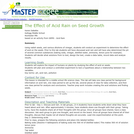
This activity is an in class lab where students will compare different acid solutions on seed germination and growth.